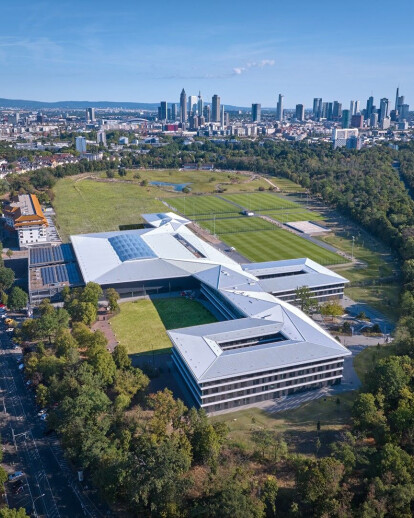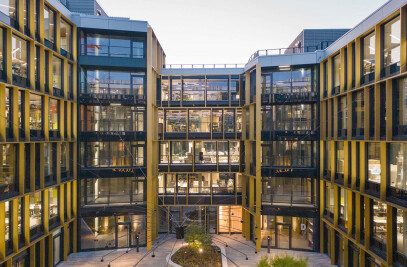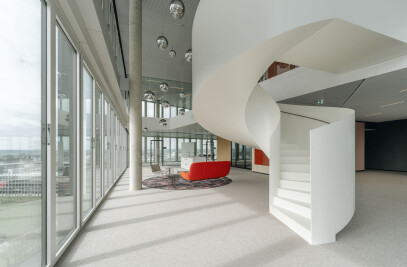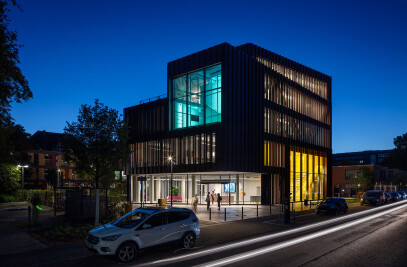BRIEF Development of a new DFB Campus, which concentrates the various areas of the association in one location | ADDED VALUE The sports fields and buildings are not separated but arranged along a main axis, which is designed as a communicative link within the campus.
DFB CAMPUS, FRANKFURT A.M. | GERMANY The DFB Campus with its football pitches, sports facilities and new building is embedded in Frankfurt’s city forest on the site of the former racecourse. It is within this green setting with a natural boundary to the surrounding areas that the mixture of structural components, sports fields, small open places, and clearings form a joint campus. The required space, including administrative areas, press centre, conference rooms, athletes’ accommodation, and state-of-the-art sports facilities, is arranged below a single long-span roof around the individual sports fields and exterior space.
The north-south-oriented covered sports boulevard connects all components and facilitates orientation. It has been designed as a communicative link with casual meeting places to watch the activities on the football pitches but also bring together the two independent institutions, administration and academy.

Sports forms architecture
The new DFB Campus is positioned in a clearing in Frankfurt’s city forest. The green setting is not only beneficial in terms of urban design but also in the way it protects the athletes and other building occupants from external influences and enables them to feel at ease in a highly focussed atmosphere.
The ensemble of buildings creates a spatial connectivity which groups the different functions in a meaningful way, encourages both concentrated work and training and, at the same time, provides an inspiring ambience for casual meetups. The design is not a conglomeration of individual buildings, which produce leftover spaces; rather, the playing fields themselves have become an integral part of the overall concept. The result is a range of open and more secluded areas that were carefully refined during the planning process. The building is embedded within this environment, provides numerous connections between the indoor and outdoor space, and incorporates some of the sports facilities in the covered area. This has the effect that spatial relationships are created with a variety of visual links, which boost the campus spirit and make sure that football is always in the limelight.
A building like a city
The DFB Campus is like a small city with a communal roof which covers a cluster of different districts. The boulevard that guides members of staff, athletes and visitors through the building is a key feature. Designed as a broad open space, it offers views into all levels of the building and the exterior space beyond the tall glass facades. This concept naturally separates the building into representative and private zones. As a result, the administrative area faces the tree-lined forecourt on Kennedyallee whereas the dining area and campus form a transition zone to the exercise rooms, the athletes’ accommodation, the indoor football arena, and multi-purpose hall. Instead of fixed boundaries, the space is characterised by close relationships and short distances, for example the proximity of the press and conference rooms to the administration or the athletes’ rooms to the sports fields. The exercise zone, including the sports lab to test new training methods, is immediately adjacent to the campus’ seminar rooms featuring a roof terrace that offers views across the football pitches to Frankfurt’s skyline in the distance.
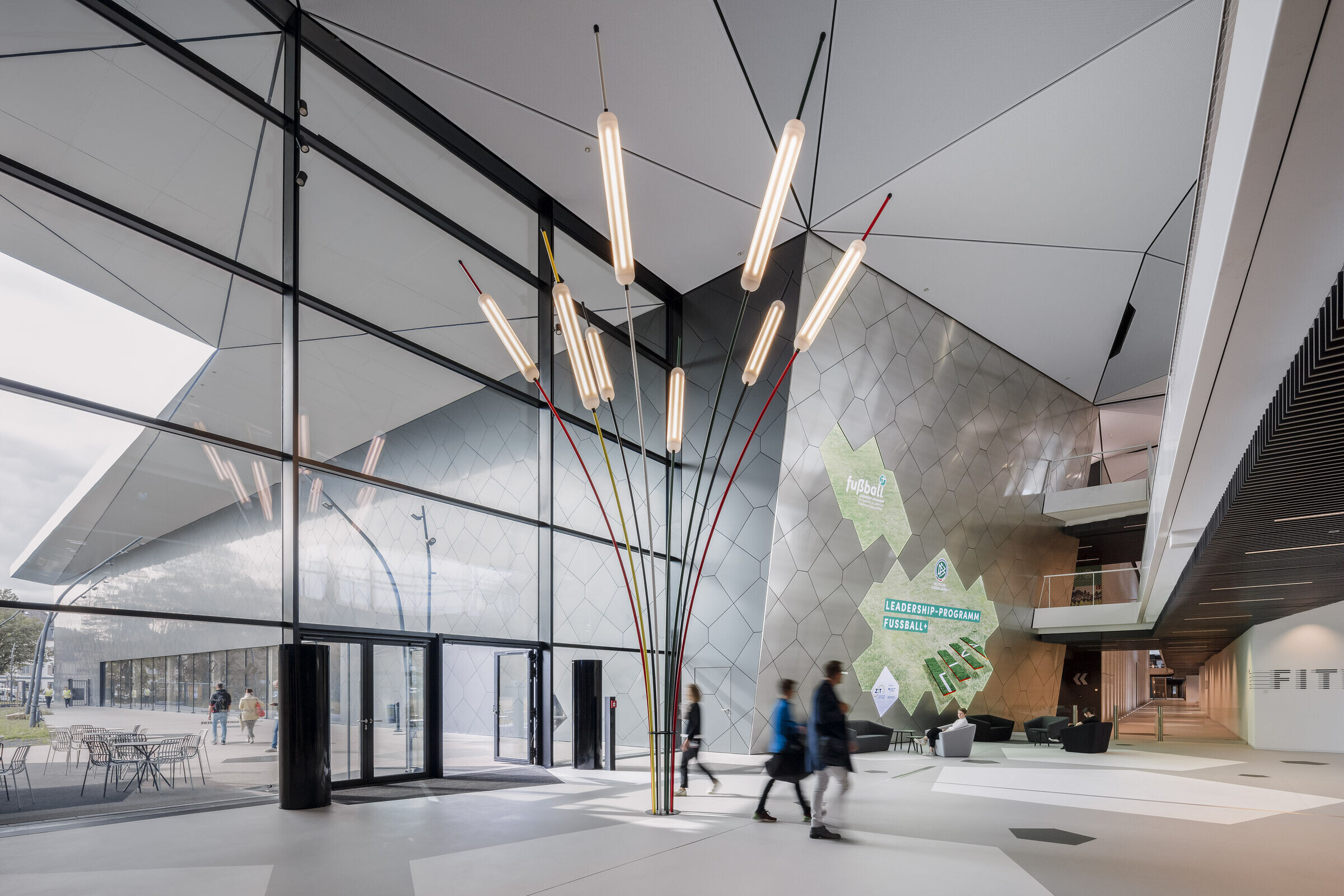
The boulevard – a thoroughfare for communication
The boulevard is the main artery of the campus. It runs the full length of the building and forms a link between the individual areas on the ground floor. The fully glazed space facilitates orientation and functions as a communication zone with an inviting atmosphere. Throughout the length of the boulevard, people can stop for a quick chat, watch the activities on the sports fields and easily find the logically arranged areas for administration, academy, and athletes’ accommodation. The boulevard is divided into two sections.
In the north, it provides access to the sports facilities with the more sheltered, internal functions including the academy, the athletes’ accommodation, exercise rooms, the indoor football arena, a multi-purpose hall as well as the market square and main entrance on Schwarzwaldstrasse. The public representative zone is located in the south and accessed via the main entrance on Kennedyallee. This is where the areas for the administration, press and visitors are located including a fan shop and large meeting rooms. The boulevard broadens at both entrance zones forming welcoming “squares”. Up above, the connecting roof rises to greater heights and, as a result, adds rhythm to the interior space.
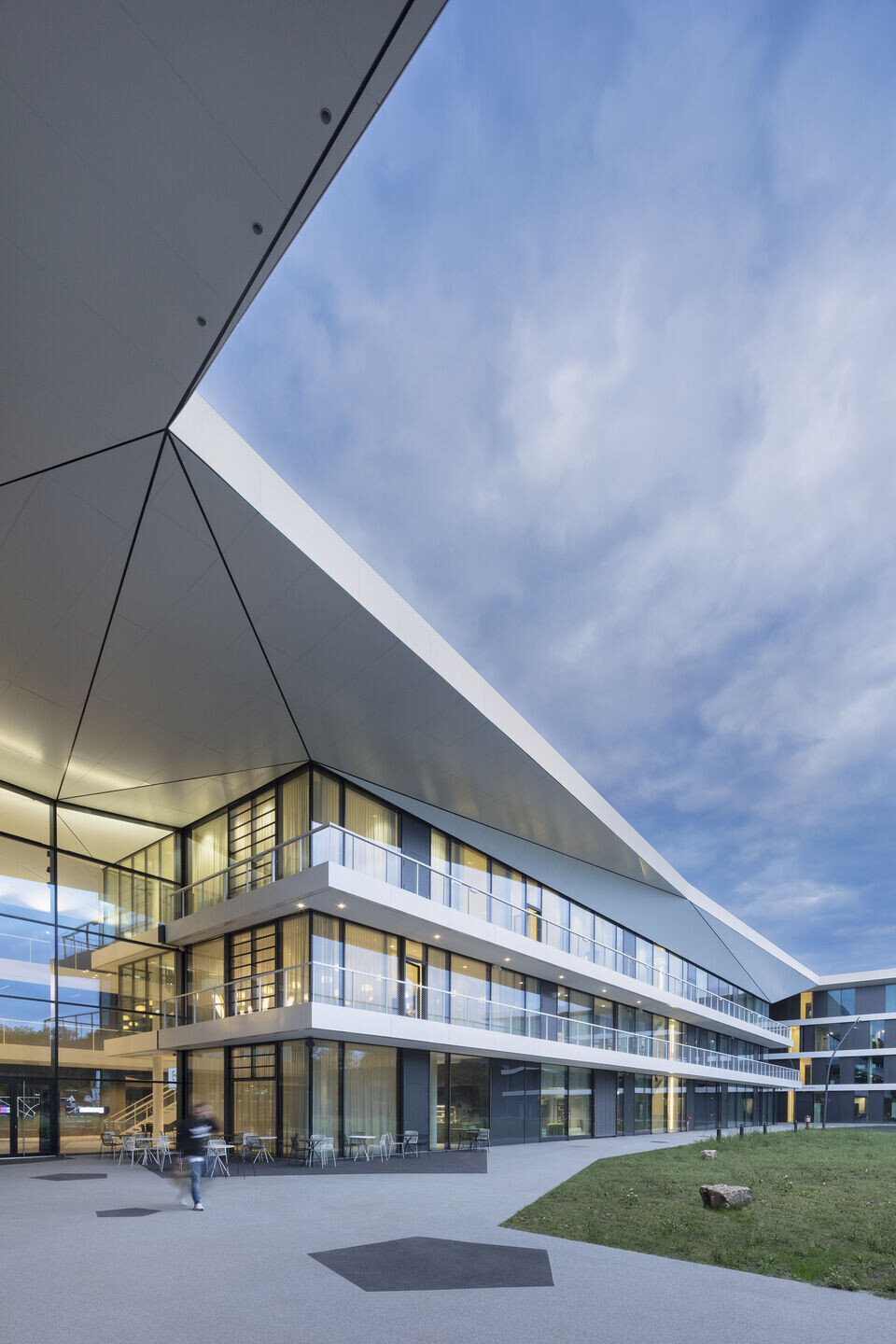
Interior: United in Diversity
The interior design concept reflects the motto “United in Diversity”. Warm colours and high-quality materials in the administration and a touch of colour with more dynamic surfaces in the world of sports convey the differences in scale. The uniform Bolidt flooring on all levels of the boulevard connects the various zones. Oblique walls with different surfaces and colours open vistas, while the folded roof above spans the entirety like a network of nodes and bars with inset triangular panels made of perforated plasterboard. As a continuous theme, the roof connects everything that the new building intends to unite: office work and active motion, play and advanced science, a welcoming feel and protected space. The continuous ribbon-like flow of the different levels is a further distinctive feature that characterises the building both inside and out.
For residents and visitors
Workshops and close cooperation with all stakeholders were key in identifying the essentials of modern collaboration and then formulating the requirements for the DFB Campus. The building offers a mix of cellular offices and zones for small teams with large interconnecting open spaces based on the latest findings on stimulating work environments. Places to retreat and meet encourage both concentrated work as well as informal exchange – an approach which has been recognised as the most important element of a successful work culture. At the same time, the individual functions are characterised by unique features, from the offices and classrooms to the sports facilities and athletes’ accommodation with bedrooms and lounge areas.
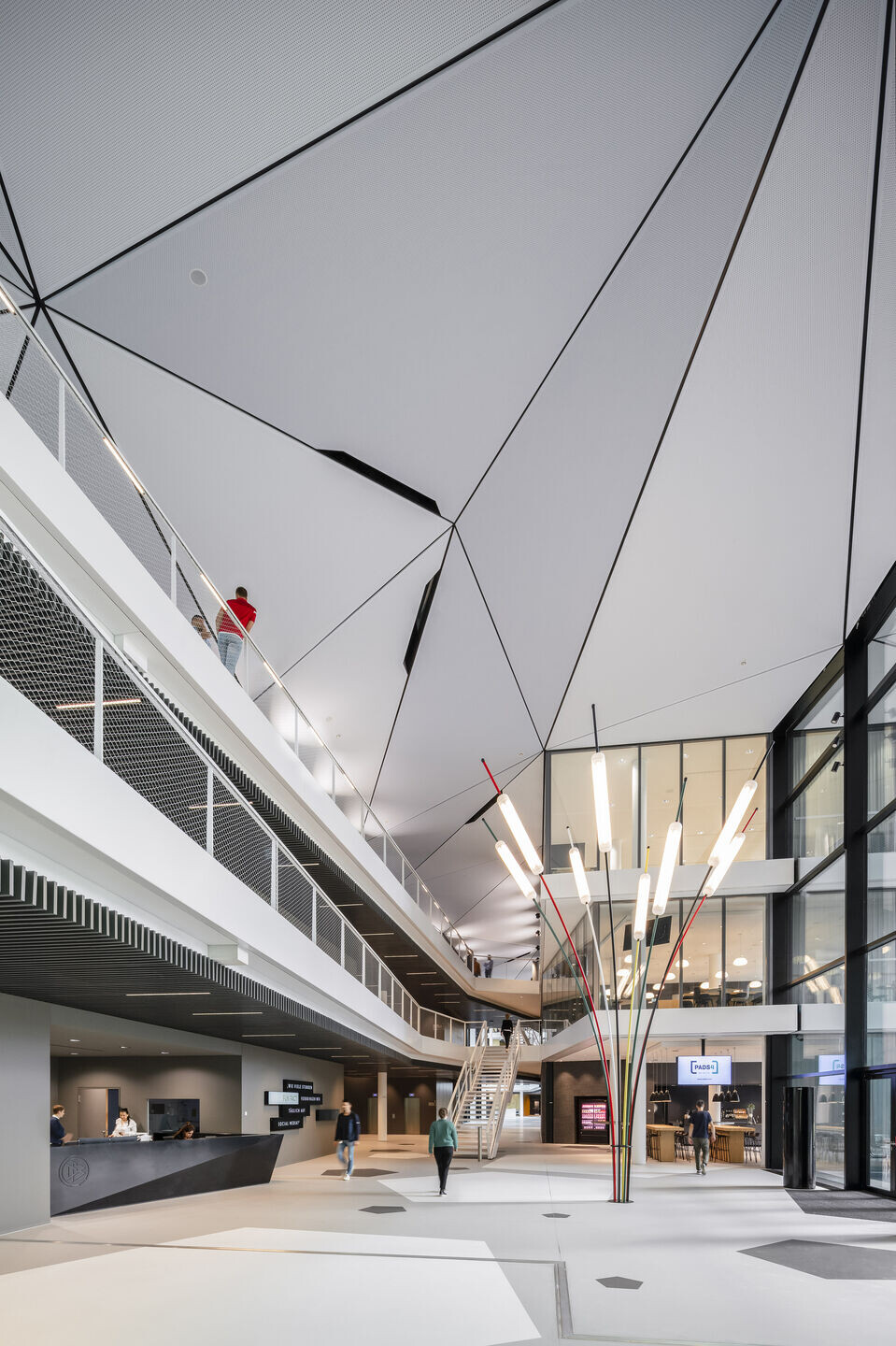
Administration
The world of work includes four core areas: the centre zone, communication and work spaces, and coffee bars for informal exchange. The workspaces are uniform and unobtrusive in their appearance. The centre zone with acoustic window and wall panels is designed to add a touch of colour; high-quality, solid surfaces create a pleasant work atmosphere. The coffee bars in different tones of green are the highlight within the office space. Despite a clear distinction in terms of design, they relate to the surfaces and colours used in the centre zone. In total, there are 540 workspaces to take care of the DFB’s varied tasks. Depending on the requirements, the desks have been arranged in open-plan or private offices.
Press
The press hall, which can be accessed from two sides, is the heart of this area. Equipped with state-of-the-art technology, it permits the use of different communication media. The work spaces for journalists with flexible seating configurations for concentrated writing are a further element of this zone. In addition, the foyer of the press area provides space to conduct interviews and exchange ideas. The entire press zone is characterised by plain coloured materials, leading to a very calm, pleasant ambience. As a result, it balances the frequent coming and going of different stakeholders and maintains a relentless focus on the communicated content.
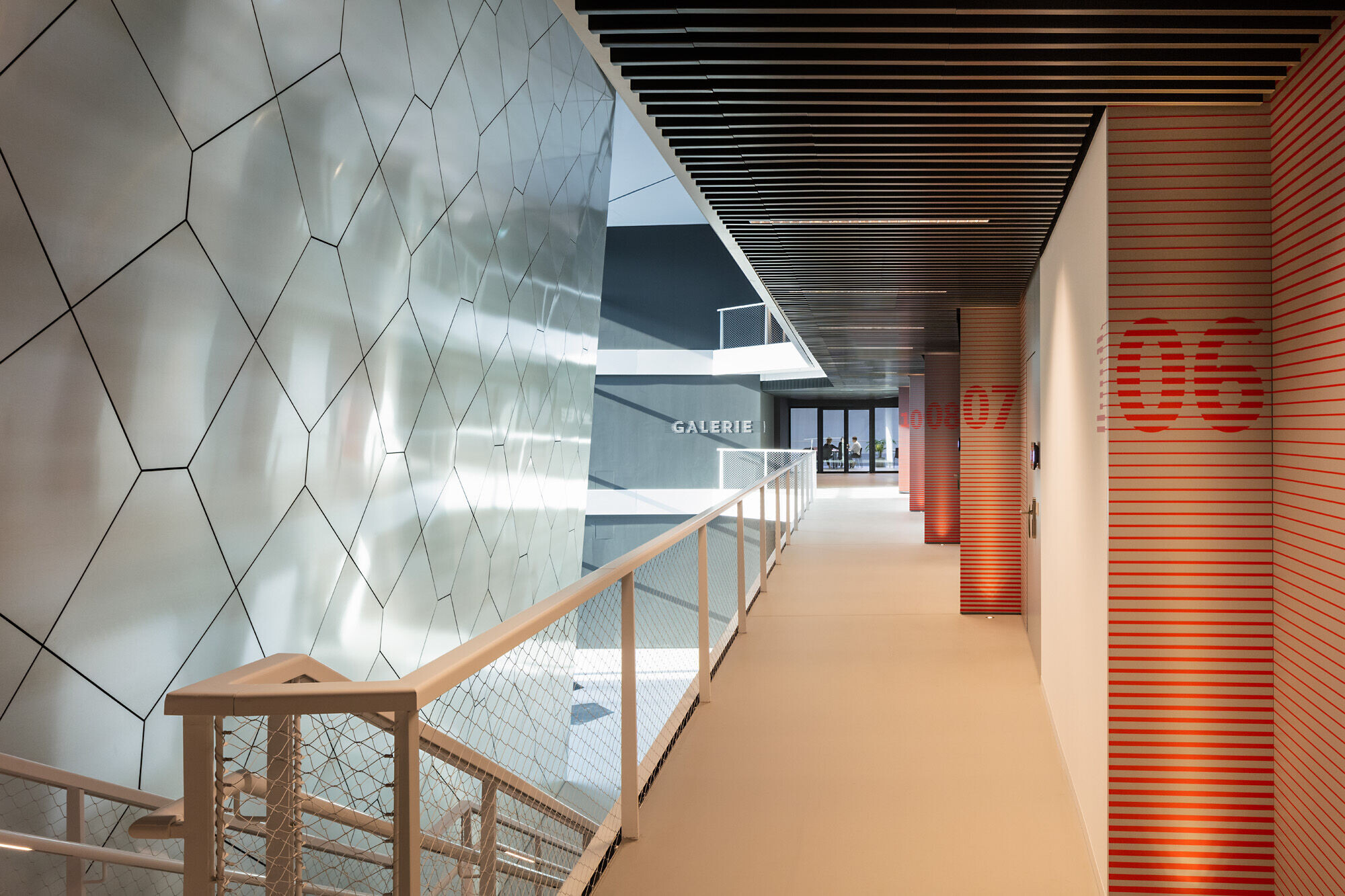
Academy
The DFB Academy is much more than just an administration building. As a repository of knowledge, a creativity workshop, training camp and education centre, it provides space for opportunities, networks resources, implements know-how and promotes young talents. The academy incorporates the areas “Education”, “National teams” as well as “Development and innovation” and draws experts from a variety of fields, including psychology, medicine, technology, sports and communication. The sports’ foyer with its intersected courtyards is located on the ground floor. It provides access to the medical surgeries, rooms for physiotherapy, wellness, and exercise, as well as the changing rooms and tech lab, where new training methods are tested.
Athletes’ accommodation
In addition to the gyms and tech lab, the three-storey accommodation for the building’s visitors, ranging from U-team players to participants of football and referee training programmes, is located north of the main square, alongside the indoor football arena. Views across the playing fields can be enjoyed from the bedrooms as well as the full length of the corridor. The exact location of the private rooms is emphasised by twisting the entrance walls out into the corridor. As a result, each room has its own individually coloured entrance space and functions as a retreat conveying a home-away-from-home feeling.
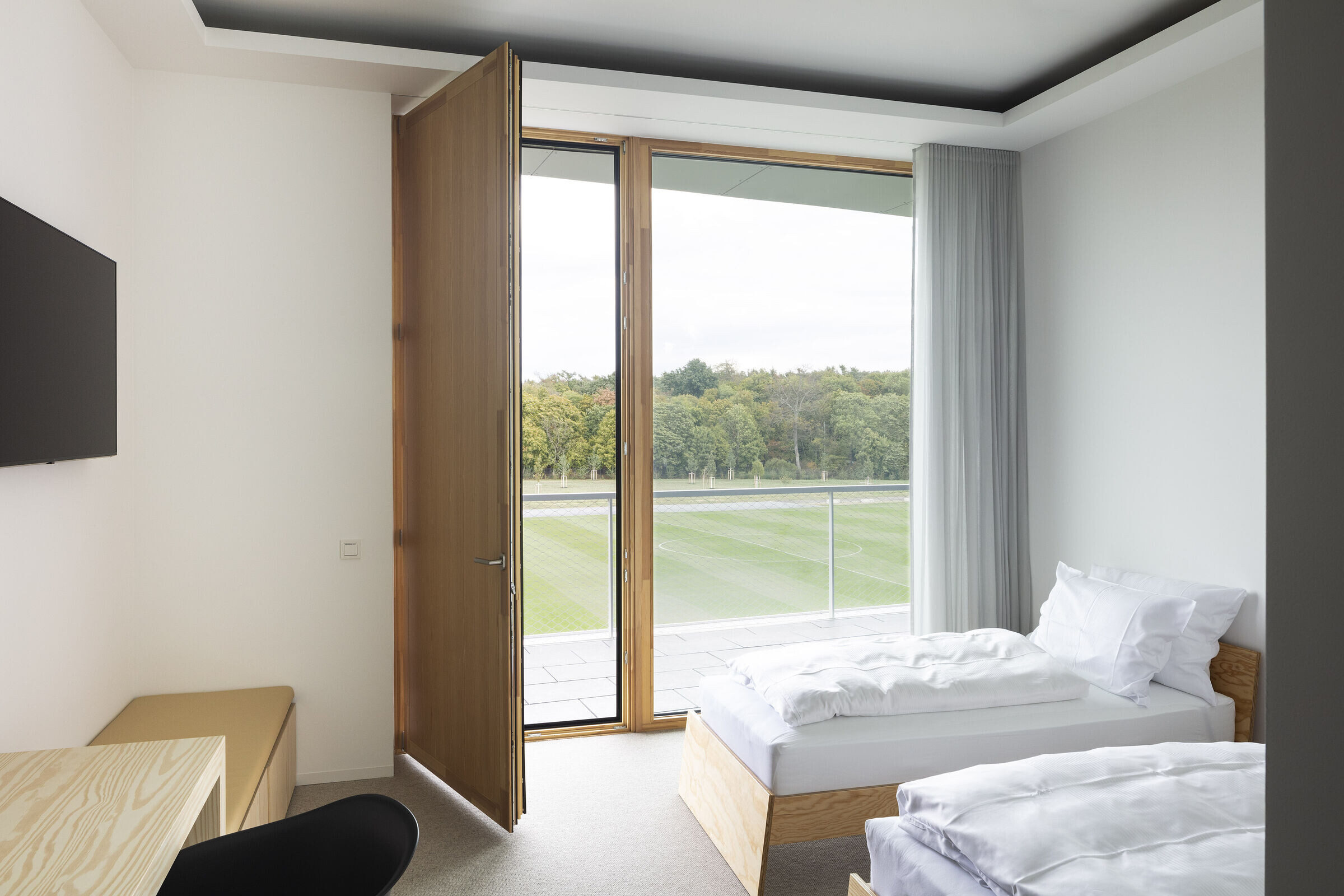
Indoor sports halls
The large indoor football arena, which complements the three natural grass pitches outside and complies with UEFA competition rules, offers the possibility to train independently from weather conditions. The spectator boxes on the two upper floors, the stands and the running track are highlights of this indoor pitch.
The smaller multi-purpose hall is also used for sports. Thanks to the white ceiling construction, light-coloured sports flooring and walls, the elegant space is also suitable for gala events.

